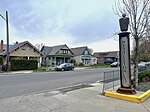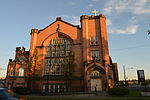Doyle's Ice Cream Parlor
1939 establishments in Washington (state)Historic district contributing propertiesNational Register of Historic Places in Spokane, WashingtonNational Register of Historic Places in Spokane County, Washington

Doyle's Ice Cream Parlor is a locally owned ice cream shop that has been located in Spokane's West Central neighborhood since 1939. Doyle's is open from spring to early fall, Wednesdays through Sundays.
Excerpt from the Wikipedia article Doyle's Ice Cream Parlor (License: CC BY-SA 3.0, Authors, Images).Doyle's Ice Cream Parlor
West Boone Avenue, Spokane
Geographical coordinates (GPS) Address Nearby Places Show on map
Geographical coordinates (GPS)
| Latitude | Longitude |
|---|---|
| N 47.6679 ° | E -117.4455 ° |
Address
West Boone Avenue 2287
99201 Spokane
Washington, United States
Open on Google Maps










